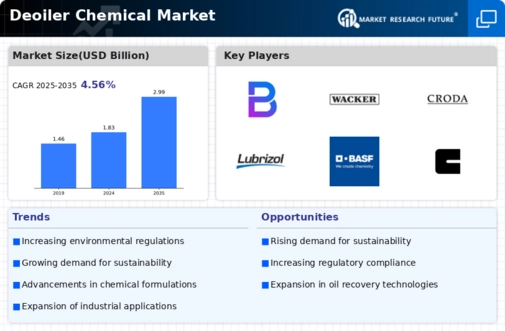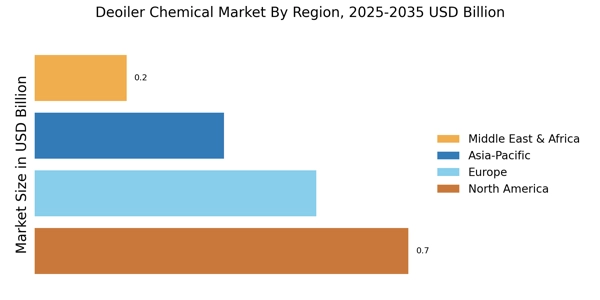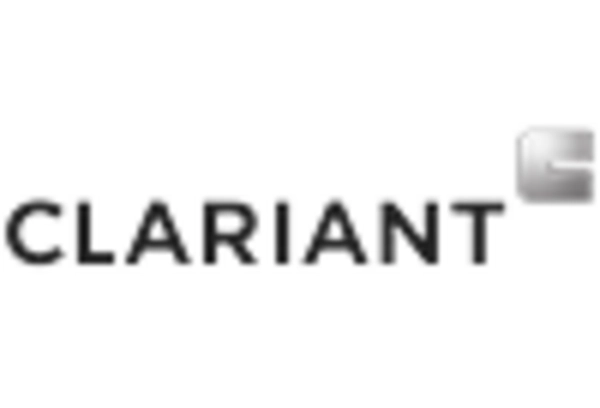Rising Demand for Oil and Gas
The Deoiler Chemical Market is experiencing a notable increase in demand driven by the oil and gas sector. As exploration and production activities expand, the need for effective deoiling solutions becomes paramount. The market is projected to grow at a compound annual growth rate of approximately 5.2% over the next five years, reflecting the industry's reliance on deoiler chemicals to enhance operational efficiency. Companies are increasingly investing in advanced deoiling technologies to meet regulatory standards and improve environmental compliance. This trend indicates a robust market potential, as the oil and gas industry seeks to optimize production while minimizing environmental impact. Consequently, the Deoiler Chemical Market is poised for growth, with manufacturers focusing on innovative solutions to cater to the evolving needs of this sector.
Growth in Industrial Applications
The Deoiler Chemical Market is witnessing substantial growth due to the increasing adoption of deoiling solutions across various industrial applications. Industries such as petrochemicals, wastewater treatment, and manufacturing are recognizing the importance of effective deoiling agents in their processes. The demand for deoiler chemicals is expected to rise as industries seek to enhance productivity and reduce operational costs. For example, the petrochemical sector is projected to account for a significant share of the market, driven by the need for efficient oil separation processes. This trend indicates a broadening scope for the Deoiler Chemical Market, as manufacturers cater to diverse industrial needs and develop tailored solutions that address specific challenges faced by different sectors.
Environmental Regulations and Compliance
The Deoiler Chemical Market is significantly influenced by stringent environmental regulations aimed at reducing pollution and promoting sustainable practices. Governments worldwide are implementing policies that necessitate the use of effective deoiling agents to mitigate the environmental impact of oil spills and wastewater discharges. This regulatory landscape compels companies to adopt advanced deoiling solutions, thereby driving market growth. The increasing emphasis on compliance with environmental standards is expected to propel the demand for deoiler chemicals, as industries strive to adhere to legal requirements while maintaining operational efficiency. As a result, the Deoiler Chemical Market is likely to witness a surge in innovation, with manufacturers developing eco-friendly and efficient products to meet these regulatory demands.
Emerging Markets and Economic Development
The Deoiler Chemical Market is poised for growth in emerging markets, where economic development is driving increased industrialization. As countries invest in infrastructure and energy projects, the demand for deoiling solutions is likely to rise. These markets present significant opportunities for manufacturers to expand their reach and introduce innovative products tailored to local needs. The growth of the oil and gas sector in these regions is particularly noteworthy, as it creates a heightened demand for effective deoiling agents. Additionally, the increasing awareness of environmental issues is prompting industries in emerging markets to adopt sustainable practices, further fueling the demand for deoiler chemicals. Consequently, the Deoiler Chemical Market is expected to thrive as it capitalizes on the potential offered by these developing economies.
Technological Innovations in Chemical Formulations
The Deoiler Chemical Market is benefiting from ongoing technological innovations in chemical formulations. Advances in research and development are leading to the creation of more effective and environmentally friendly deoiling agents. These innovations not only enhance the performance of deoiler chemicals but also align with the growing demand for sustainable solutions. For instance, the introduction of bio-based deoiling agents is gaining traction, as they offer a lower environmental footprint compared to traditional chemicals. The market is expected to see a shift towards these innovative formulations, which could potentially capture a larger share of the market. As companies prioritize sustainability and efficiency, the Deoiler Chemical Market is likely to evolve, with a focus on developing cutting-edge products that meet the needs of various industries.


















Leave a Comment